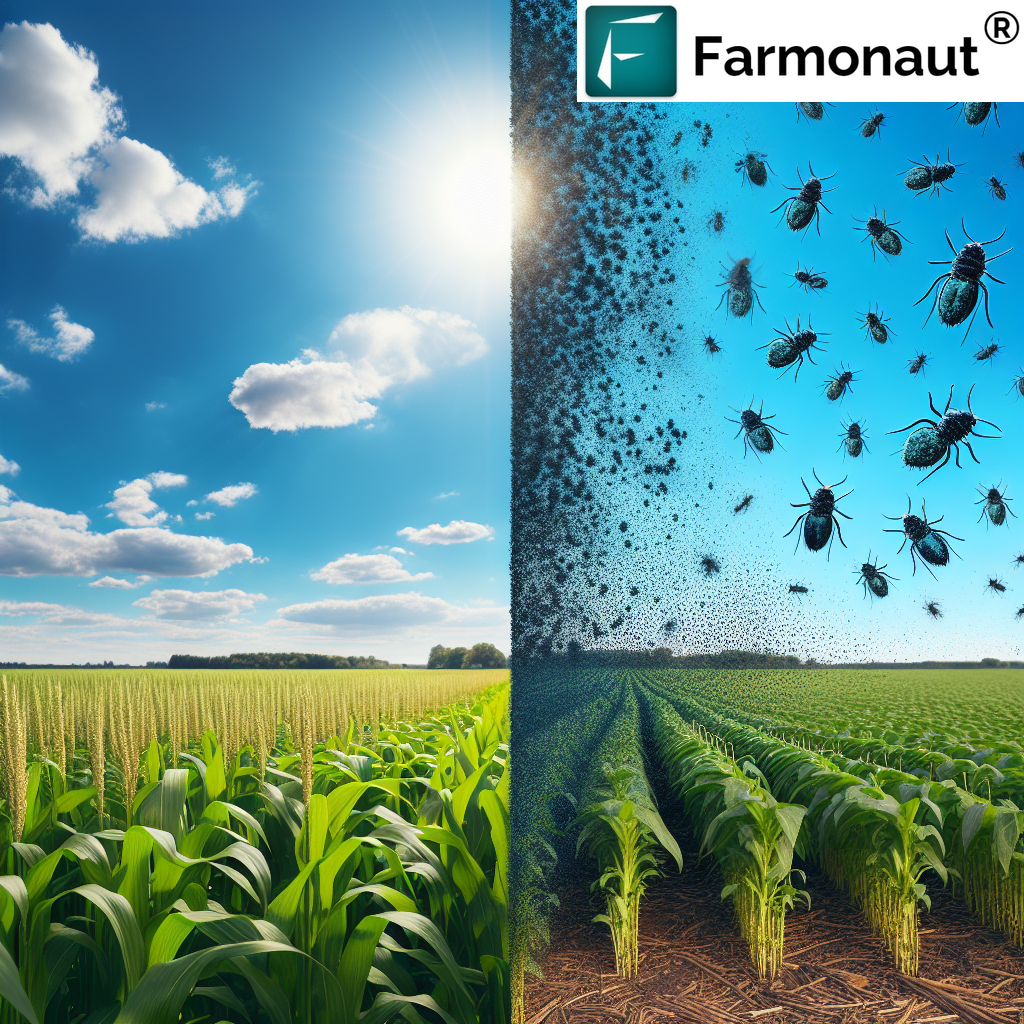Mastering Heat Stress Management: Boost Dairy Cow Health and Milk Production with Farmonaut’s Smart Grazing Solutions
“Heat stress can reduce milk production by 79-169 litres per cow during heatwaves, impacting dairy farm profitability.”
Welcome to our comprehensive guide on heat stress management in dairy farming. As climate challenges continue to impact agricultural practices worldwide, we at Farmonaut understand the critical importance of adapting to these changes. In this blog post, we’ll explore sustainable grazing practices and innovative agritech solutions that can help farmers optimize milk production while prioritizing livestock welfare.
Heat stress is a significant concern for dairy farmers, affecting not only the health and comfort of their cows but also impacting milk yield and quality. As global temperatures rise, the need for effective heat stress management strategies becomes increasingly crucial. Let’s dive into the world of smart grazing solutions and discover how you can boost your dairy farm’s productivity while ensuring the well-being of your herd.
Understanding Heat Stress in Dairy Cows
Before we delve into management strategies, it’s essential to understand what heat stress is and how it affects dairy cows. Heat stress occurs when the environmental temperature exceeds the cow’s thermal neutral zone, making it difficult for them to maintain their normal body temperature. This can lead to various physiological and behavioral changes that negatively impact their health and productivity.
- Reduced feed intake
- Increased water consumption
- Higher respiration rates
- Decreased milk production
- Impaired fertility
- Weakened immune system
As dairy farmers, our primary goal is to mitigate these effects and create an environment where our cows can thrive, even during the hottest months of the year.
The Impact of Heat Stress on Milk Production
The consequences of heat stress on dairy farm productivity cannot be overstated. Research has shown that during heatwaves, milk production can decrease by 79 to 169 litres per cow. This significant drop in yield can have severe economic implications for dairy farmers, making it crucial to implement effective heat stress prevention strategies.
“Global warming is extending the heat stress season for dairy cows, necessitating adaptive management strategies for farmers.”
With climate change extending the heat stress season, it’s more important than ever to adapt our management practices to ensure the long-term sustainability of our dairy operations. By implementing smart grazing solutions and leveraging advanced technologies, we can maintain optimal milk production levels while prioritizing cow welfare.
Smart Grazing Solutions for Heat Stress Management
At Farmonaut, we believe in the power of technology to revolutionize farming practices. Our satellite-based farm management solutions can provide valuable insights to help you implement effective heat stress management strategies. Let’s explore some key approaches to combat heat stress in your dairy herd:
1. Implementing a “Siesta” Management Program
One innovative approach to managing heat stress is the implementation of a “siesta” program. This strategy involves adjusting the grazing schedule to allow cows to rest during the hottest parts of the day. Here’s how you can implement this program:
- Allow cows to graze during cooler morning and evening hours
- Provide access to shaded areas or cool housing during peak heat hours
- Ensure ample water availability throughout the day
- Monitor cow behavior and adjust the schedule as needed
By aligning grazing patterns with cooler periods, we can reduce the heat load on our cows and maintain their comfort and productivity.
2. Optimizing Shade Provision
Adequate shade is crucial for protecting cows from direct sunlight and reducing heat stress. Here are some tips for optimizing shade provision in your pastures:
- Plant trees strategically to create natural shade areas
- Install artificial shade structures in pastures lacking natural cover
- Ensure shade areas are large enough to accommodate your entire herd
- Rotate shade areas to prevent overgrazing and soil compaction
Farmonaut’s satellite imagery can help you identify areas in your pastures that may benefit from additional shade coverage, allowing you to make informed decisions about shade provision.
3. Maintaining Proper Water Access
Access to clean, cool water is essential for helping cows regulate their body temperature and maintain milk production during hot weather. Consider the following strategies:
- Provide multiple water sources throughout grazing areas
- Ensure water troughs are cleaned regularly
- Monitor water temperature and implement cooling systems if necessary
- Adjust water flow rates to meet increased demand during hot weather
Our AI-powered advisory system, Jeevn AI, can help you optimize water management by providing real-time insights on weather patterns and cow behavior.
4. Housing Cows During Peak Heat Hours
Sometimes, the best way to protect cows from extreme heat is to bring them indoors during the hottest parts of the day. Consider these factors when implementing this strategy:
- Design housing facilities with proper ventilation and cooling systems
- Use fans and sprinklers to create a comfortable microclimate
- Ensure adequate space for all cows to rest comfortably
- Provide access to feed and water within the housing area
By utilizing Farmonaut’s weather forecasting capabilities, you can plan ahead and determine the best times to house your cows indoors.
5. Optimizing Shed Ventilation
Proper ventilation in cow sheds is crucial for maintaining a comfortable environment and reducing heat stress. Here are some tips for optimizing shed ventilation:
- Install fans to increase air movement
- Use misting systems to cool the air
- Ensure proper insulation to minimize heat transfer from the roof
- Design open sides or adjustable curtains for natural ventilation
Our satellite-based monitoring can help you assess the effectiveness of your ventilation systems by tracking temperature patterns in and around your sheds.
6. Implementing Rotational Grazing Techniques
Rotational grazing can help manage heat stress by ensuring cows have access to fresh, high-quality pasture while allowing for rest and recovery of grazed areas. Here’s how to implement this technique:
- Divide pastures into smaller paddocks
- Rotate cows through paddocks based on grass growth and quality
- Allow adequate rest periods for each paddock
- Monitor pasture conditions using satellite imagery and on-ground observations
Farmonaut’s satellite-based crop health monitoring can provide valuable insights into pasture conditions, helping you make informed decisions about grazing rotations.
Leveraging Technology for Heat Stress Management
At Farmonaut, we believe that technology plays a crucial role in modern agriculture. Our advanced solutions can help you implement and optimize heat stress management strategies:
- Satellite-Based Crop Health Monitoring: Monitor pasture health and identify areas that may need attention or rotation.
- Jeevn AI Advisory System: Receive personalized recommendations for heat stress management based on real-time data and weather forecasts.
- Fleet and Resource Management: Optimize the use of machinery and resources for implementing heat stress management strategies.
- Carbon Footprinting: Track and reduce your farm’s environmental impact while implementing sustainable grazing practices.
By integrating these technologies into your dairy farm management, you can make data-driven decisions that improve both cow welfare and milk production.
Explore our web app for comprehensive farm management solutions:
Heat Stress Management Strategies Comparison
| Strategy | Implementation | Benefits | Estimated Impact on Milk Production |
|---|---|---|---|
| Siesta Management Program | Adjust grazing schedule to cooler hours | Reduced heat exposure, improved rest | Up to 10% increase |
| Shade Provision | Install natural and artificial shade structures | Protection from direct sunlight, cooler environment | 5-15% increase |
| Water Access Optimization | Multiple water sources, regular cleaning | Improved hydration, temperature regulation | Up to 8% increase |
| Peak Heat Hour Housing | Provide indoor housing during hottest hours | Reduced heat exposure, controlled environment | 10-20% increase |
| Shed Ventilation Improvement | Install fans, misting systems, proper insulation | Enhanced air circulation, cooler indoor climate | 7-12% increase |
| Rotational Grazing Techniques | Divide pastures, rotate cows based on grass quality | Access to high-quality forage, pasture recovery | Up to 15% increase |
This table provides a quick overview of the various heat stress management strategies we’ve discussed. By implementing a combination of these approaches, you can significantly reduce the impact of heat stress on your dairy cows and maintain optimal milk production levels.
The Role of Nutrition in Heat Stress Management
While environmental management is crucial, nutrition also plays a vital role in helping cows cope with heat stress. Consider the following nutritional strategies:
- Increase the energy density of the diet to compensate for reduced feed intake
- Provide additional minerals and electrolytes to replace those lost through sweating
- Offer feed during cooler hours when cows are more likely to eat
- Consider using feed additives that support rumen health and digestion
Farmonaut’s AI-powered advisory system can help you optimize your feeding strategies based on environmental conditions and cow performance data.
Monitoring and Adapting Your Heat Stress Management Plan
Effective heat stress management requires ongoing monitoring and adaptation. Here are some key points to consider:
- Regularly assess cow behavior and performance indicators
- Monitor weather forecasts and adjust management practices accordingly
- Use technology like Farmonaut’s satellite monitoring to track pasture health and cow movement patterns
- Continuously educate yourself and your staff on the latest heat stress management techniques
By staying vigilant and adaptable, you can ensure that your heat stress management plan remains effective throughout the changing seasons.
Access our API for custom integration of satellite and weather data:
Farmonaut API
Learn more about integrating our solutions with our API Developer Docs:
API Developer Docs
The Economic Benefits of Effective Heat Stress Management
Implementing comprehensive heat stress management strategies may require initial investments, but the long-term economic benefits are significant:
- Maintained or improved milk production during hot periods
- Enhanced cow health, resulting in reduced veterinary costs
- Improved fertility rates and reduced calving intervals
- Extended productive lifespan of cows
- Potential for premium milk prices due to consistent quality
By leveraging Farmonaut’s technology to implement and monitor these strategies, you can maximize the return on your investment in heat stress management.
Sustainable Practices and Environmental Considerations
As we implement heat stress management strategies, it’s crucial to consider their environmental impact. Sustainable grazing practices not only benefit our cows but also contribute to the overall health of our planet. Here are some eco-friendly approaches to consider:
- Implement agroforestry techniques to provide natural shade and improve biodiversity
- Use water-efficient cooling systems to reduce resource consumption
- Explore renewable energy options for powering ventilation and cooling equipment
- Practice soil conservation techniques to maintain healthy pastures
Farmonaut’s carbon footprinting tools can help you track and reduce your farm’s environmental impact while implementing these sustainable practices.
The Future of Heat Stress Management in Dairy Farming
As we look to the future, the integration of advanced technologies will play an increasingly important role in heat stress management for dairy farms. Some emerging trends include:
- Precision livestock farming using IoT devices and wearable sensors
- Advanced climate control systems for indoor housing
- Genetic selection for heat-tolerant cow breeds
- Development of novel feed additives to support cow health during heat stress
At Farmonaut, we’re committed to staying at the forefront of these innovations, continuously updating our platform to provide you with the most advanced tools for managing your dairy farm.
Conclusion: Empowering Dairy Farmers with Smart Grazing Solutions
Mastering heat stress management is crucial for maintaining the health and productivity of dairy cows in an ever-changing climate. By implementing smart grazing solutions and leveraging advanced technologies like those offered by Farmonaut, dairy farmers can significantly reduce the impact of heat stress on their herds.
Remember, effective heat stress management involves a combination of strategies, including:
- Implementing a siesta management program
- Optimizing shade provision and water access
- Housing cows during peak heat hours
- Improving shed ventilation
- Utilizing rotational grazing techniques
- Adapting nutritional strategies
By embracing these approaches and utilizing data-driven insights, we can create a more resilient and sustainable dairy industry that prioritizes both cow welfare and milk production optimization.
At Farmonaut, we’re dedicated to supporting dairy farmers in their journey towards more effective heat stress management. Our comprehensive suite of tools and technologies is designed to provide you with the insights and capabilities you need to make informed decisions and implement successful strategies.
Download our mobile apps for on-the-go farm management:
Frequently Asked Questions (FAQ)
- What is the optimal temperature range for dairy cows?
The thermal neutral zone for dairy cows is generally between 5°C and 25°C (41°F to 77°F). Above this range, cows may start experiencing heat stress. - How can I tell if my cows are experiencing heat stress?
Signs of heat stress include increased respiration rate, reduced feed intake, decreased milk production, and seeking shade or water more frequently. - What is the most effective way to cool cows in a pasture setting?
A combination of shade provision, access to clean, cool water, and implementing a siesta management program can be highly effective in pasture settings. - How does heat stress affect milk quality?
Heat stress can lead to reduced milk fat and protein content, as well as increased somatic cell count, which can impact overall milk quality. - Can heat stress impact cow fertility?
Yes, heat stress can significantly impact fertility by reducing conception rates, increasing early embryonic loss, and altering estrous behavior. - How often should I rotate pastures during hot weather?
The frequency of rotation depends on factors like pasture size, grass growth, and herd size. Generally, more frequent rotations (every 1-3 days) can be beneficial during hot weather to ensure access to high-quality forage. - Are there any specific breeds of dairy cows that are more heat-tolerant?
Some breeds, such as Jersey and Brown Swiss, tend to be more heat-tolerant than others. However, individual variation within breeds also plays a role. - How can Farmonaut’s technology help me manage heat stress in my dairy herd?
Farmonaut’s satellite-based monitoring, AI advisory system, and weather forecasting capabilities can help you make informed decisions about grazing management, pasture health, and implementing timely heat stress mitigation strategies.
We hope this comprehensive guide has provided you with valuable insights into mastering heat stress management for your dairy herd. By implementing these smart grazing solutions and leveraging Farmonaut’s advanced technologies, you can boost your dairy cow health and milk production, even in the face of climate challenges.

Farmonaut Subscriptions
Ready to take your dairy farm management to the next level? Explore our subscription options and start leveraging the power of satellite technology and AI-driven insights today. Together, we can create a more resilient and productive future for dairy farming.
















